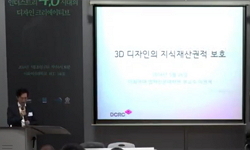3D printing technology has been actively applied for the restoration of cultural properties. However, its application to the restoration of glass cultural properties has not yet been reported and thus requires further study. In this study, 3D printing...
http://chineseinput.net/에서 pinyin(병음)방식으로 중국어를 변환할 수 있습니다.
변환된 중국어를 복사하여 사용하시면 됩니다.
- 中文 을 입력하시려면 zhongwen을 입력하시고 space를누르시면됩니다.
- 北京 을 입력하시려면 beijing을 입력하시고 space를 누르시면 됩니다.

보물 제1925호 금강산 출토 이성계 발원 사리장엄구 내 유리제사리병 복원 및 안정성 연구 = Restoration and Stability of the Glass sarira Bottle(treasure No. 1925) from the sarira Reliquaries Commissioned by Yi Seonggye, Excaved from Geumgangsan Mountain
한글로보기부가정보
다국어 초록 (Multilingual Abstract)
transparent materials used to restore ceramics to evaluate their usability and stability. A total of five specimens were produced, including from photocurable resin made by a stereo lithography apparatus (SLA), epoxy resin, acrylic resin, and more. They were exposed to UV for 96 hours to test for yellowing. Of the two specimens made of photocurable resins and exposed to UV, one was sprayed with a UV blocking agent but the other was exposed as-is.
The UV exposure test showed that the specimen made by the SLA and sprayed with a UV blocking agent and the specimen made of epoxy resin were stable in terms of yellowing with a change in the b-value was less than 1. They are thus considered to be suitable materials for the restoration of glass cultural properties. Such glass cultural properties are often diverse in shape and their restoration can be difficult as they generally consist of a range of complex parts that hamper restoration. In this regard, diverse materials should be considered when selecting materials for the restoration of glass cultural properties.
3D printing technology has been actively applied for the restoration of cultural properties. However, its application to the restoration of glass cultural properties has not yet been reported and thus requires further study. In this study, 3D printing technology was used to restore a defective part of a glass sarira bottle that forms an element of a series of sarira reliquaries commissioned by Yi Seonggye (known as King Taejo after founding the Joseon Dynasty) that was xcavated from Geumgangsan Mountain (designated as Treasure No. 1925) and is currently housed at the National Museum of Korea. The defective area was reproduced using 3D printing and the printed reproduction was reproduced again using an epoxy resin. This latter piece was used as the restoration component rather than the 3D printed element. After the completion of the conservation treatment, the materials used for the 3D printing were compared with
transparent materials used to restore ceramics to evaluate their usability and stability. A total of five specimens were produced, including from photocurable resin made by a stereo lithography apparatus (SLA), epoxy resin, acrylic resin, and more. They were exposed to UV for 96 hours to test for yellowing. Of the two specimens made of photocurable resins and exposed to UV, one was sprayed with a UV blocking agent but the other was exposed as-is.
The UV exposure test showed that the specimen made by the SLA and sprayed with a UV blocking agent and the specimen made of epoxy resin were stable in terms of yellowing with a change in the b-value was less than 1. They are thus considered to be suitable materials for the restoration of glass cultural properties. Such glass cultural properties are often diverse in shape and their restoration can be difficult as they generally consist of a range of complex parts that hamper restoration. In this regard, diverse materials should be considered when selecting materials for the restoration of glass cultural properties.
국문 초록 (Abstract)
자외선 노출 결과, SLA방식 시편에 UV차단제를 분무한 시편, 에폭시계수지의 시편의 b*값의 변화값이 1 미만으로 황변화에 안정적인 것으로 나타났으며 유리제 문화재의 복원제로써 적용 가능한 재료로 보여진다. 유리제 문화재의 형태가 매우 다양하고 복원해야할 부분 또한 다양하고 복잡하여 접근하기 어려울 수 있으므로 복원재료에 대해 여러 가지 재료를 염두해두고 고민해볼 필요가 있다.
문화재 복원 분야에서 3D 기술이 복원에 적용되고 있다. 그러나 아직까지 유리제 문화재의 복원에 관하여 3D 기술이 활용되어 복원된 사례가 적으며 이에 관한 연구가 필요한 상황이다. 이에 ...
문화재 복원 분야에서 3D 기술이 복원에 적용되고 있다. 그러나 아직까지 유리제 문화재의 복원에 관하여 3D 기술이 활용되어 복원된 사례가 적으며 이에 관한 연구가 필요한 상황이다. 이에 본 연구에서는 국립중앙박물관에서 소장하고 있는 보물인 금강산 출토 이성계 발원 사리장엄구 일괄 중 유리제 사리병의 결손부를 복원하는 과정에 3D 기술을 이용하였다. 보존처리는 3D 프린팅 출력물을 직접적으로 복원제로써 적용하지않고 에폭시계수지로 복제한 복원편으로 결손부를 복원하였다. 보존처리 완료 후 3D 프린팅에 사용되는 재료와 기술방식에 관하여 기존 도자기의 복원재료 중 투명성을 지닌 재료를 선택하여 사용감과 안정성을 비교하고자 하였다. 보존처리 완료 후 SLA(Stereo Lithography Apparatus)방식으로 출력한 광경화성 수지, 에폭시계 수지, 아크릴계 수지등 총 5개의 시편을 제작 한 후 96시간까지 자외선에 노출시켜 황변화를 조사하였고, 광경화성수지의 시편은 출력물에 UV차단제를 분무 여부에 따라 2종으로 나누어 자외선에 노출시켰다.
자외선 노출 결과, SLA방식 시편에 UV차단제를 분무한 시편, 에폭시계수지의 시편의 b*값의 변화값이 1 미만으로 황변화에 안정적인 것으로 나타났으며 유리제 문화재의 복원제로써 적용 가능한 재료로 보여진다. 유리제 문화재의 형태가 매우 다양하고 복원해야할 부분 또한 다양하고 복잡하여 접근하기 어려울 수 있으므로 복원재료에 대해 여러 가지 재료를 염두해두고 고민해볼 필요가 있다.
동일학술지(권/호) 다른 논문
-
석조 문화재 보존용 저황변Epoxy의 제조 및 물성 연구
- 국립중앙박물관
- 이승연, 오승준, 위광철
- 2021
- KCI등재후보
-
천안 성거산 위례성 출토 목어의 적외선 조사 및 보존처리
- 국립중앙박물관
- 조상윤, 김수철
- 2021
- KCI등재후보
-
국립중앙박물관 소장 갑주(甲冑)의 보존처리와 구조적 특징
- 국립중앙박물관
- 박진호, 박지혜, 황진영
- 2021
- KCI등재후보
-
부여 능산리사지 출토 금제구슬의 재료학적 특성 및 제작 기법 연구
- 국립중앙박물관
- 양수현, 노지현
- 2021
- KCI등재후보




 RISS
RISS







